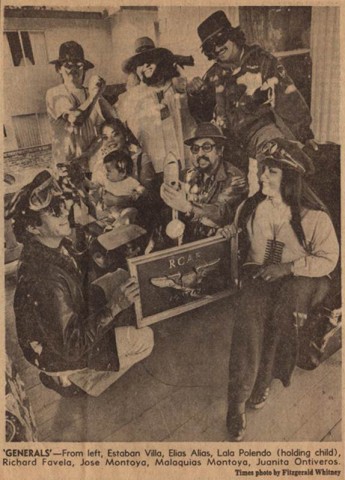Aztlán Spotlight Article
The Necessary Theater of the Royal Chicano Air Force
by Ella Maria Diaz
Abstract: Drawing on Jorge Huerta’s concept of necessary theater, this essay contends that performances of the Royal Chicano Air Force’s collective persona paralleled performances of the farmworker actos pioneered by El Teatro Campesino. Through visualizations, performances, and articulations of the air force persona, the RCAF enacted a defense against physical violence and the destruction of Chicana/o art in the 1970s and also negotiated the group’s gender dynamics. The essay concludes by documenting an RCAF performance that used the rasquache aesthetic of farmworker actos to reject the mainstream media’s portrayal of a militant madness in the Chicano movement.
In 1979, a photograph of the Royal Chicano Air Force (RCAF) ran in the Los Angeles Times alongside an article by staff writer Charles Hillinger. Captioned “Generals,” the photo shows RCAF members decked out in captain’s hats, flight goggles, bomber jackets, and aviator sunglasses (fig. 1). Two members, Esteban Villa and Juanita Ontiveros, hold opposite ends of a plaque emblazoned with the RCAF’s acronym and a pair of pilot’s wings. In the article, Hillinger quotes RCAF co-founder José Montoya on the origins of the group’s name:
We started out as a group of artists and poets teaching at California State University, Sacramento, calling ourselves the Rebel Chicano Art Front. . . . But right from the start, everyone began confusing our abbreviation, RCAF, with the Royal Canadian Air Force. So we capitalized on the confusion and renamed the group the Royal Chicano Air Force. (Hillinger 1979, 3)
Founded as a Chicana/o arts collective in Sacramento, California, in 1969, the RCAF was known as an “air force” in the Chicano movement for ten years prior to the publication of this article and photograph. The air force identity suited the group, since many members had served in the US armed forces during the Korean conflict or the Vietnam War.[i] The air force identity also helped members respond with a sense of duty to the urgent needs of Sacramento’s Chicana/o community.

Figure 1. “Generals.” From left: Esteban Villa, Elias Alias, Lala Polendo (holding child), Ricardo Favela, José Montoya, Malaquias Montoya, and Juanita Ontiveros. Published in the Los Angeles Times, July 22, 1979. Clipping in the author’s collection. Photograph by Fitzgerald Whitney. Copyright © 1979 Los Angeles Times. Reprinted with permission.
[i] During the Korean conflict, José Montoya served in the US Navy and Esteban Villa served in the US Army. During the Vietnam War, Armando Cid, Hector González, and Juanishi Orosco served in the US Army.
To order this issue of Aztlán: The Journal of Chicano Studies, contact support@chicano.ucla.edu.
